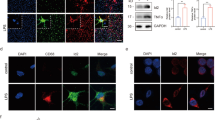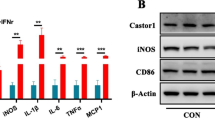Abstract
Microglia, the major immune cells of the central nervous system (CNS), can be driven to adopt M1 and M2 phenotypes. Recently, the distinct functions of M1 and M2 microglia have been intensively studied. M1-activation microglia are pro-inflammatory and may contribute to the development of several CSN disorders, while M2-activation microglia are anti-inflammatory and may promote tissue reconstruction. TRAM1 is a protein involved in translocation of nascent polypeptides and functions as a sorting adaptor of TLR4. Here, we found that TRAM1 plays an important role in microglia M1 polarization. Our results showed that the expression of TRAM1 is highly induced in LPS/interferon (IFN)-γ-stimulated BV2 cells and primary microglia cells. Flag-TRAM1 transfection, but not Flag-GFP used as a control, significantly enhanced M1 polarization by strongly increasing expression of M1 makers, such as IL-6, IL-1β, iNOS, and so on. Silence of TRAM1 effectively inhibited LPS/IFN-γ-induced expression of M1-related genes in BV2 cells. In addition, TRAM1 was found to cooperate with TLR4 to induce an M1 genetic program in Flag-TRAM1-transfected and LPS/IFN-γ-induced BV2 cells. TRAM1 is essential for LPS/IFN-γ induced expressions of adapter molecule (IRAK1, phosphorylation of TBK1, and IRF3) of TLR4. TRAM1 is also essential for phosphorylation of IκB and P65 and for P65-NF-kB translocation to nucleus. Overall, our findings showed that TRAM1 could promote microglia M1 polarization.




Similar content being viewed by others
References
Ajmone-Cat MA, Mancini M, et al. (2013) Microglial polarization and plasticity: evidence from organotypic hippocampal slice cultures. Glia 61(10):1698–1711
Akira S, Takeda K (2004) Toll-like receptor signalling. Nat Rev Immunol 4(7):499–511
Chhor V, Le Charpentier T, et al. (2013) Characterization of phenotype markers and neuronotoxic potential of polarised primary microglia in vitro. Brain Behav Immun 32:70–85
Colton C, Wilcock DM (2010) Assessing activation states in microglia. CNS Neurol Disord Drug Targets 9(2):174–191
Colton CA, Mott RT, et al. (2006) Expression profiles for macrophage alternative activation genes in AD and in mouse models of AD. J Neuroinflammation 3:27
Crain JM, Nikodemova M, et al. (2013) Microglia express distinct M1 and M2 phenotypic markers in the postnatal and adult central nervous system in male and female mice. J Neurosci Res 91(9):1143–1151
David S, Kroner A (2011) Repertoire of microglial and macrophage responses after spinal cord injury. Nat Rev Neurosci 12(7):388–399
Ellert-Miklaszewska A, Dabrowski M, et al. (2013) Molecular definition of the pro-tumorigenic phenotype of glioma-activated microglia. Glia 61(7):1178–1190
Ghosh M, Subramani J, et al. (2015) CD13 restricts TLR4 endocytic signal transduction in inflammation. J Immunol 194(9):4466–4476
Gwack Y, Srikanth S, et al. (2007) Biochemical and functional characterization of orai proteins. J Biol Chem 282(22):16232–16243
Hanisch UK, Kettenmann H (2007) Microglia: active sensor and versatile effector cells in the normal and pathologic brain. Nat Neurosci 10(11):1387–1394
Hirotani T, Yamamoto M, et al. (2005) Regulation of lipopolysaccharide-inducible genes by MyD88 and toll/IL-1 domain containing adaptor inducing IFN-beta. Biochem Biophys Res Commun 328(2):383–392
Hu X, Li P, et al. (2012) Microglia/macrophage polarization dynamics reveal novel mechanism of injury expansion after focal cerebral ischemia. Stroke 43(11):3063–3070
Kagan JC, Medzhitov R (2006) Phosphoinositide-mediated adaptor recruitment controls toll-like receptor signaling. Cell 125(5):943–955
Kagan JC, Su T, et al. (2008) TRAM couples endocytosis of toll-like receptor 4 to the induction of interferon-beta. Nat Immunol 9(4):361–368
Kim M, Choi SY, et al. (2015) Neochlorogenic acid inhibits lipopolysaccharide-induced activation and pro-inflammatory responses in BV2 microglial cells. Neurochem Res 40(9):1792–1798
Lawrence T, Natoli G (2011) Transcriptional regulation of macrophage polarization: enabling diversity with identity. Nat Rev Immunol 11(11):750–761
Liu B, Hong JS (2003) Role of microglia in inflammation-mediated neurodegenerative diseases: mechanisms and strategies for therapeutic intervention. J Pharmacol Exp Ther 304(1):1–7
Mantovani A, Sozzani S, et al. (2002) Macrophage polarization: tumor-associated macrophages as a paradigm for polarized M2 mononuclear phagocytes. Trends Immunol 23(11):549–555
Martinez FO, Helming L, et al. (2009) Alternative activation of macrophages: an immunologic functional perspective. Annu Rev Immunol 27:451–483
Minghetti L, Levi G (1998) Microglia as effector cells in brain damage and repair: focus on prostanoids and nitric oxide. Prog Neurobiol 54(1):99–125
Ng CL, Oresic K, et al. (2010) TRAM1 is involved in disposal of ER membrane degradation substrates. Exp Cell Res 316(13):2113–2122
Oshiumi H, Sasai M, et al. (2003) TIR-containing adapter molecule (TICAM)-2, a bridging adapter recruiting to toll-like receptor 4 TICAM-1 that induces interferon-beta. J Biol Chem 278(50):49751–49762
Plociennikowska A, Hromada-Judycka A, et al. (2015) Co-operation of TLR4 and raft proteins in LPS-induced pro-inflammatory signaling. Cell Mol Life Sci 72(3):557–581
Ponomarev ED, Maresz K, et al. (2007) CNS-derived interleukin-4 is essential for the regulation of autoimmune inflammation and induces a state of alternative activation in microglial cells. J Neurosci 27(40):10714–10721
Ponomarev ED, Veremeyko T, et al. (2011) MicroRNA-124 promotes microglia quiescence and suppresses EAE by deactivating macrophages via the C/EBP-alpha-PU.1 pathway. Nat Med 17(1):64–70
Rivest S (2011) The promise of anti-inflammatory therapies for CNS injuries and diseases. Expert Rev Neurother 11(6):783–786
Rojo AI, Innamorato NG, et al. (2010) Nrf2 regulates microglial dynamics and neuroinflammation in experimental Parkinson’s disease. Glia 58(5):588–598
Rowe DC, McGettrick AF, et al. (2006) The myristoylation of TRIF-related adaptor molecule is essential for Toll-like receptor 4 signal transduction. Proc Natl Acad Sci U S A 103(16):6299–6304
Shimizu E, Kawahara K, et al. (2008) IL-4-induced selective clearance of oligomeric beta-amyloid peptide(1–42) by rat primary type 2 microglia. J Immunol 181(9):6503–6513
Smith PF (2008) Inflammation in Parkinson’s disease: an update. Curr Opin Investig Drugs 9(5):478–484
Tanaka T, Murakami K, et al. (2015) Interferon regulatory factor 7 participates in the M1-like microglial polarization switch. Glia 63(4):595–610
Tremblay ME, Stevens B, et al. (2011) The role of microglia in the healthy brain. J Neurosci 31(45):16064–16069
Verreck FA, de Boer T, et al. (2004) Human IL-23-producing type 1 macrophages promote but IL-10-producing type 2 macrophages subvert immunity to (myco)bacteria. Proc Natl Acad Sci U S A 101(13):4560–4565
Verstak B, Nagpal K, et al. (2009) MyD88 adapter-like (Mal)/TIRAP interaction with TRAF6 is critical for TLR2- and TLR4-mediated NF-kappaB proinflammatory responses. J Biol Chem 284(36):24192–24203
Wang X, Stridh L, et al. (2009) Lipopolysaccharide sensitizes neonatal hypoxic-ischemic brain injury in a MyD88-dependent manner. J Immunol 183(11):7471–7477
Zimmermann M (1983) Ethical guidelines for investigations of experimental pain in conscious animals. Pain 16(2):109–110
Acknowledgments
This work was supported by the National Basic Research Program of China (973 Program, No. 2012CB822104); the National Natural Science Foundation of China (Nos. 31500647, 31440037, and 31270802); the Natural Science Foundation of the Jiangsu Higher Education Institutions of China (15KJA310003); the Natural Science Foundation of Jiangsu Provience (BK20150408); and a project funded by the Priority Academic Program Development of Jiangsu Higher Education Institutions (PAPD).
Author information
Authors and Affiliations
Corresponding authors
Ethics declarations
Conflict of Interest
The authors declare no conflict of interest.
Additional information
Hanxiang Wang and Chun Liu contribute equally to this work.
Rights and permissions
About this article
Cite this article
Wang, H., Liu, C., Han, M. et al. TRAM1 Promotes Microglia M1 Polarization. J Mol Neurosci 58, 287–296 (2016). https://doi.org/10.1007/s12031-015-0678-3
Received:
Accepted:
Published:
Issue Date:
DOI: https://doi.org/10.1007/s12031-015-0678-3




